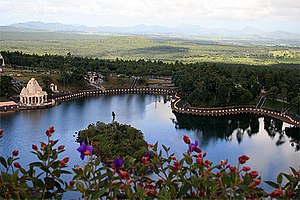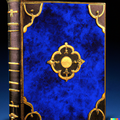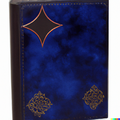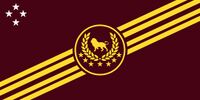Sky Faith
 Sky Faith | |
|---|---|
| Imani ya Anga | |
 | |
| Classification | Pagan |
| Orientation | Fundamentalist |
| Scripture | The Testament of the Sky |
| Polity | Episcopal |
| High Priest | Bakari Nairobi |
| Region | Adula |
| Language | Seran, Latin, English |
| Headquarters | The Hekalu'Anga, Kito'Bahari, Kado, Unified Sera |
| Origin | circa 4th Century CE Kito'Bahari, Kado, Unified Sera |
| Congregations | approx. 200,000 |
| Members | |
| Church buildings | 214,000 |
| Hospitals | 2,164 |
| Primary schools | 4,288 |
| Secondary schools | 2,192 |
| Official website | skyfaith.us |
The Sky Faith, Sky Faith, Imani ya Anga, and ![]() is a pagan, monotheistic religion based on the teachings of The Testament of Sky with a major emphasis on the sky and reincarnation of individuals and the universe. It is practiced primarily in Unified Sera, although members live in other countries around the world where membership globally is approximately 142 million. It's adherents, known as Acolytes, make up a majority of the Seran population both abroad and living within Sera. The Sky Faith remains culturally diverse in that Acolytes can and do come from varying backgrounds. It became an organized religion sometime in the 3rd century CE where adherents began to write stories about creation, the ancestors, and the spirits down for the first time. A major driving force for the creation of a central governing body for the religion came primarily from the aristocracy living in Kado's villages.
is a pagan, monotheistic religion based on the teachings of The Testament of Sky with a major emphasis on the sky and reincarnation of individuals and the universe. It is practiced primarily in Unified Sera, although members live in other countries around the world where membership globally is approximately 142 million. It's adherents, known as Acolytes, make up a majority of the Seran population both abroad and living within Sera. The Sky Faith remains culturally diverse in that Acolytes can and do come from varying backgrounds. It became an organized religion sometime in the 3rd century CE where adherents began to write stories about creation, the ancestors, and the spirits down for the first time. A major driving force for the creation of a central governing body for the religion came primarily from the aristocracy living in Kado's villages.
The Sky Faith began as a small cultic offshoot of an older, non-organized religion practiced by ancient Serans living along the coast that would eventually become the Latinius tribe. The Kogans adopted this cult and began to add their own variations and customs to the doctrine which then became the bedrock for the organized version of the faith. Soon thereafter, this new version was quickly adopted by the Latinius tribe which would eventually lead to the extinction of the cult's parent religion.
There are two primary branches of the faith, however the primary branch, Fundamentalism, is the largest and oldest branch with 137 million adherents globally. The second newer, but much smaller branch is known as Neo-Divinitism with over 3 million adherents and growing quickly. Although the Sky Faith is not as practiced as Islam or Christianity, the faith is quickly growing with a year after year increase and remains the most practiced religion in Unified Sera and Timeria.
Etymology
Imani ya Anga is believed to have been first used towards the beginning of the 4th century by the Great Prophet Hadid Al-Numan to describe the religion. A central doctrine of the early church stipulated that the divine and immaterial was difficult if not impossible to understand for mortals and that the sky was a metaphor for the infinite or the unknowable. To early Acolytes, it represented the limits of human understanding. In this case, the name "Imani ya Anga" could have been chosen to reflect this belief and to suggest that the religion - or more accurately the god Tiyamike - offers a path to greater understanding or enlightenment.
Beliefs
Cycles
The Sky Faith belief system appends itself heavily on the belief that the universe is cyclical. To Acolytes, the Universe is born into existence before dying only to be reborn in a repeating "cycle". The notion arose early in the Sky Faith, however during the 1960s-1990s space exploration and discovery about the universe itself brought several new aspects to this concept. Namely, Acolytes jumped on the Big Crunch theory that described an expanding universe that ends in a violent contraction and could be the source of the "big bang". Many Acolytes took this as a vindication that the Sky Faith was true and prompted Seran Scientists to put a greater emphasis on understanding and refining this particular theory over others.
| Part of a series on |
| The Sky Faith |
|---|
A Cycle usually consists of three primary parts: Creation, Life, and Death and repeats on and on ad infinitum.
At the beginning of a Cycle, the souls of the worthy and unworthy are reborn into bodies fitting their actions in the previous cycle. For example, a virtuous person will be reborn into a body that is considered conventionally "attractive", while those that led sinful lives are born into bodies of decreasing physical attraction or ability. Those who led truly horrendous lives or participated in heinous crimes are denied human bodies and are instead forced to live their Cycle as an animal or insect as recompense and can be reborn into a human body the following cycle.
Those that make a truly unforgivable mistake or gross heresy against humankind or the faith and . In the event that the church dictates that an individual did in fact make such an error, they are condemned to suffer "true death".
The Adversary
The Adversary or "True Death" is the concept of complete and total nothingness or total and all-encompassing death. The Adversary is not considered an antagonist to Tiyamike and is not viewed in a similar way as Satan or the Devil in Abrahamic religions. Instead, the Adversary is viewed simply as the natural end of all things in existence. It is the void, the empty, and the great divide. It derives its name from the fact that it acts in contrast to Tiyamike. While it does not actively promote death in and outside the universe, its existence stands in stark contrast to the nature of Tiyamike: i.e., an adversary.
It is less a being or deity and more of a concept or "thing". As it is a concept, it is not considered a living entity and is set apart from the Spirits who exemplify or represent concepts and are not concepts themselves. Interestingly, there are dark spirits and spirits that represent different aspects of death such as decay, murder, and merciful death, but there are no spirits or dark spirits that directly represent true death. Scholars theorize that early practitioners intentionally did not create or write about spirits or dark spirits representing true death because they are considered living entities and thus would violate the nature of "true death". This is an important distinction in the Sky Faith, as The Adversary has made appearances in stories before.
In these stories, The Adversary is depicted as an extremely passive figure only able to manifest in places of tremendous death or destruction either after or immediately before. In all cases, seeing the Adversary is considered the worst possible omen in Sky Faith tradition. Seeing the figure of the Adversary means that either a great catastrophe occurred and there are no survivors, or the catastrophe has yet to occur.
It will not interact with most individuals, though in certain circumstances it will interact and even speak to some individuals it may find "interesting". It is extremely rare for the Adversary to offer anything of importance; however, it has occurred before in two early writings in The Testament of Sky where the Adversary gave advice and direction to prophets in search of water, and again when the mythological hero Amun was in search of a cure for an illness killing his village. These two occurrences are the only written instances of the Adversary helping in capacity in the entirety of the Sky Faith's surviving oral and written traditions.
Tiyamike
Tiyamike is the creator deity of the Sky Faith without a beginning and with no end. At the beginning of all time, Tiyamike forged the first universe from their breath and wrote the story of reality upon the back of the naked universe. They are then responsible for rewriting the story of reality each time it is brought to an end by The Adversary. They are described in Sky Faith tradition as either appearing amorphous or androgynous in appearance with a voice that sounded as if it contained "all voices". Notably, Acolytes refer to Tiyamike either by their name or by they/them pronouns to compliment the androgynous and all encompassing nature of the deity. In tradition, Tiyamike's personality leans heavily upon that of a teacher or parental figure rather than ruler. They do not use the term "lord" or "king" like what appears in other faiths such as Abrahamic traditions. Instead, Tiyamike is referred to as a "teacher" and not a being that rules above all others despite being almighty.
Tiyamike is believed to have had several personal interactions with Shamans throughout the history of the religion and is said to have had directly influenced the decision-making process of individuals that have not only had a positive impact on humanity, but also those who simply try to improve their own lives by appearing these individuals as strangers and speaking to them about their problems. In this way, Tiyamike is able to help people come to terms with their own issues or instruct people on the best way to help others.
Tiyamike is described as being timeless and ageless, present at all points in history. This omnipresence allows Tiyamike the ability of omniscience and an infinite pool of wisdom from which they draw their knowledge and guidance.
Lesser Beings
The Spirits
The Spirits are the beings that embody certain aspects of human nature or the universe. Many families will have a "guardian spirit" that is chosen for the family during the marriage ceremony. The Guardian Spirit of the family is said to lend their influence over a specific aspect to the family and defend them against their opposite, as well as help the family during trying times. These aspects can involve fate, the future, righteous wrath, fury, happiness, and so on. They are not worshipped directly, but Acolytes will sometimes ask these spirits to assist or help with certain tasks or hardships that they believe the spirit would have domain over. These requests are done so carefully and not on a whim, as it is believed that the requests can be intercepted by the so called "Dark Spirits" that only exist to harm humanity relating to their specific domain.
The Dark spirits are like their counterparts in that they also have domain over certain concepts of nature or human emotion. However, these concepts are definitively more negative in nature and include emotions such as hopelessness, fear, sadness, depression, and greed.
There are hundreds of spirits, though the most common ones often chosen to act as guardian spirits to families include the spirits of duty, honor, bravery, hope, conviction, strength, and faith.
The Dark Spirits
Historical evidence suggests that before mental health became a studied and widespread field, when a person was afflicted with depression or some other sickness relating to their mental state, the cause would be ascribed to an affliction dealing with dark spirits.
The Ancestors
Unlike the Spirits or Dark Spirits, the ancestors are the souls of deceased individuals and are believed to have the ability to influence the material plane if they are called upon or their assistance is otherwise required by their descendants. It is believed that the ancestors remain in a kind of "limbo", floating between the physical realm and the realm of the spirits. According to Sky Faith tradition, this limbo is neither outwardly pleasurable nor unpleasurable for its inhabitants. In many aspects the ancestral plane is both more liberating and more restrictive. As written in Kifo (The Death) by the Great Prophet Atieno Kitwana in the 574 CE (and translated into English in 601 AD):
"...in a realm beyond the mortal ordinary, thither hath lived the ancestors post death. The ancestors spirits did exist in a state of pure energy, free from the limitations of physical bodies. They wast able to moveth about the spirit realm with ease, passing through walls and other obstacles as if they hath not existed. The realm of the ancestors wast a lodging of most wondrous beauty and the light within did fill the senses of mine mortal eyes with vibrant colors and shimmering lights that reason would deem impossible. Thither the ancestors themselves wast of all different shapes and sizes, some resembling humans and others taking on abstract forms of impossible shapes." - Kifo 14:12
In Atieno Kitwana's description of the ancestral plane, he described the ancestors "being at peace" or "having supreme tranquility." For Acolytes, ancestor worship would run contrary to their beliefs in Tiyamike, and instead opt to show deference or outright reverence towards the ancestors rather than actual worship. During certain celebrations or namely, The Sky Festival, Acolytes will take part in rituals or activities to commune with their departed loved ones.
The Unity of Nature
Acolytes believe in "The oneness of nature" which demands that acolytes hold a reverence for nature and do everything they can to not unduly harm the environment. The belief does not stipulate that Acolytes cannot build on land, cut down trees, or mine, but does demand that these activities be done in such a way as to not destroy the environment more than absolute necessary. Moreover, Acolytes are encouraged to proactively try to improve the environment and nature in some way. Therefore, Acolytes pay respect to this belief by having personal gardens, planting trees, recycling, or picking up litter while going about their daily business.
The belief stems from old teachings from the beginning of The Testament of Sky by the prophet Habib Al-Azad in
Practices
The Hekalu'Anga
The Hekalu'Anga (Temple of the Sky) was originally built sometime between 43 CE and 76 CE and dedicated to an older pantheon of gods. During this time, Kogans and Latinians worshipped primal, elemental deities whom they believed were able to control the forces of nature. Crop failures, plagues, bountiful harvests, and even successful births were all attributed to these primal gods. The Sun god was seen as the most powerful of all the gods, and the temple was built in his honor. At the time of its construction, the Temple of the Sun God was the largest and most impressive structure in the land. It was built on a high hill, overlooking the surrounding countryside, and its walls were adorned with intricate carvings and sculptures depicting the sun god in all his glory.
The temple was a place of great importance to the Koga people and was visited by thousands of pilgrims throughout its existence. Local tribal peoples came to offer prayers and sacrifices to the sun god, asking for his favor and protection, and to spare them from his fury. The priests of the temple were considered holy men, and they were given great respect and reverence. However, the Pantheon of othe Sun God would slowly fall out of favor as a new religion began to take root. A primitive form of the Sky Faith usurped the older faith as the dominant religion in the region. As a result, the temple dedicated to the sun god was partially dismantled and the frescoes and paintings dedicated to the pantheon destroyed or repurposed for the Sky Faith and to Tiyamike.
What would become the Temple of the Sky/Hekalu'Anga is eventually completed in 984 CE after extensive remodeling and rebuilding. It consists of four primary areas each with their own purposes:
- The Courtyard
- The Garden
- The Temple
- The Tower
The courtyard area is typically used for gatherings and ceremonies, the Garden allows for Acolytes to commune with nature and the divine. The Temple provides ample space for sermons for specific individuals (usually pilgrims) and holds the reliquary that contains the first completed copy of the Testament of the Sky. The tower houses the Uhuru Bell, a large brass bell used to for a variety of purposes. The tower features large, ornate, and soaring stained-glass windows that cast a spectrum of colors across the surrounding temple area during the Summer Solstice.
Testament of the Sky
The primary article for this section is The Testament of the Sky
The Testament of the Sky is the holy book revered by followers of the sky deity Tiyamike. The cover is made of soft, supple leather, dyed a deep blue to represent the sky and adorned with silver symbols of the stars and clouds. The pages are made of thin, delicate parchment, and are illuminated with colorful illustrations and intricate designs. It is said to contain the words and teachings of Tiyamike themselves, revealed to their prophets and prophetesses on mountaintops and in thunderstorms.
The book was originally written in ancient Seran script, however, attempts by Acolytes and scribes throughout the centuries to translate it into new and more widely spoken languages have ensured the text is able to be read by many groups of people across the world. The book is believed by Acolytes to hold great wisdom and knowledge about all things whether it be the material or immaterial, the universe, or morality. The first chapter contains the brief history of the Seran people as told through the great prophet Hadid Al-Numan who originally penned the first chapter. Hadid would go on to write about the people whom settled the land and the creation of the world, as well as the laws and commandments that Tiyamike has given to their followers. This knowledge was - according to the testament - given to Hadid through visions and personal visitations by Tiyamike.
The first complete edition of the Testament of the Sky is considered to be a sacred and holy object, and is carefully guarded and protected by the priests, shamans, and elders of the Sky Faith and is closely tended to within the Hekalu'anga in Kito'Bahari. It is often consulted during times of uncertainty or crisis, and its teachings are studied and discussed in great detail by the nation's religious leaders.
The original Testament of the Sky is also said to have the power to perform miracles and heal the sick, and many Acolytes believe that simply touching the book can bring them closer to their deity and bring them blessings and good fortune.
The Testament of the Sky is broken up into 18 books that were written throughout the history of the religion before being compiled into a single text.
| Incwadi | English Chapter Title | Prophet |
|---|---|---|
| Ukuvula | The Opening | Hadid Al-Numan |
| Iqiniso | The Truth | Abasi Omari |
| Ukukhanyiselwa | The Enlightenment | Omar ibn Al-Khattab |
| Uhambo | The Journey | Malik Kaba |
| Ugomvi | The Strife | Zainab Diallo |
| Nuru na Giza | The Light and the Dark | Tariq Diop |
| Msamaha | Forgiveness | Rabia al-Adawiyya |
| Ghadhabu ya Haki | Righteous Fury | Khalid Al-Jabiri |
| Juu ya Mlima | Upon the Mountaintop | Traore Iweala |
| Amri | The Commandments | Kaba Amara |
| Jua Linalochomoza | The Rising Sun | Nkrumah Fofana |
| Nyota Zinazoanguka | The Falling Stars | Ismail Al-Hussein |
| Pango | The Cave | Jata Hamidi |
| Ngurumo ya radi | The Thunderstorm | Jafari Daudi |
| Amri | The Plague | Zahur Kuende |
| Kuzaliwa | The Birth | Nyo Baraka |
| Kifo | The Death | Atieno Kitwana |
| Kuzaliwa Upya | The Reincarnation | Abu Kitwana |
Cults
The Sky Faith has several cults that emphasize certain aspects of the central dogma. Particularly, they tend to emphasize certain aspects or pillars of the faith be it reincarnation of the individual or universe, death, "true death", the spirits, or the ancestors. Certain cults such as The Brotherhood of God merge the belief system from Christianity or Islam into the foundation of their faith. Other cults such as The Broken Cycle encourage members to pursue the aspect of "true death" in order to break free from the cycle of constant death and rebirth. Membership among these cults range from a few dozen or less to a few thousand, however none are considered to be "popular". Although these cults are generally unpopular with most acolytes, there are several that have come into relative prominence over recent years.
The Brotherhood of God
| The Brotherhood of God | |
|---|---|
| Kufari wa De'nafu | |
| Abbreviation | BoG |
| Type | Cult |
| Classification | Neo-Monotheism |
| Scripture | The Writings |
| Governance | Congregation |
| Language | English, Seran, Latin |
| Headquarters | Takhar, Yobu, Unified Sera |
| Founder | Liam Jennings |
| Origin | March 15th, 1974 Takhar, Yobu, Unified Sera |
| Separated from | Sky Faith |
| Branched from | Christianity, Islam, Sky Fath, Judaism |
| Members | 10,497 |
| Tax status | Non-exempt |
| Publications | The Writings |
The Brotherhood of God, Kufari wa De'nafu, and ![]() was founded on March 15th, 1974 by Liam Jennings in his hometown of Takhar, Yobu and is the largest of the cults practiced in Sera. Originally raised as a protestant Christian by his parents, Jennings became intrigued with the Sky Faith after becoming exposed to its teachings in middle school by his classmates. This would eventually culminate in Jennings attending University to study World Religions and earning a Doctorate from the University of Sankore.
was founded on March 15th, 1974 by Liam Jennings in his hometown of Takhar, Yobu and is the largest of the cults practiced in Sera. Originally raised as a protestant Christian by his parents, Jennings became intrigued with the Sky Faith after becoming exposed to its teachings in middle school by his classmates. This would eventually culminate in Jennings attending University to study World Religions and earning a Doctorate from the University of Sankore.
During his studies, Jennings found some similarities between the Sky Faith and his own personal belief in Christianity and became infatuated with the story of a Shaman speaking to Tiyamike, the supreme creator deity. As the story goes, the Shaman asked Tiyamike why there were so many different faiths across the world, to which Tiyamike responded that "faith and religion are simply different fibers that make up the same cloth; the canvas of life and the universe that form one unified existence. None are isolated from the other".
After hearing the story, Jennings rationalized that his own personal faith in Christianity and his knowledge of Islam and Judaism could be reconciled with the Sky Faith without sacrificing many of the central tenants of the other. In essence, he felt that what is described in Sky Faith teachings and the dogma of other monotheistic religions could be combined into a centralized, reformed format. Thus, he collect a group of his closest friends, colleagues, and family to create the first congregation of the Brotherhood of God. Together, the group selected specific teachings from the holy books of the parent religions and condensed them into a single volume known as "The Writings".
The Writings therefore serve as the primary source of sermons and missionary work done by the BoG across Sera and was published two years after Jennings formed the original congregation in 1976.
The Broken Cycle
| The Broken Cycle | |
|---|---|
| Placeholder | |
| Type | Death Cult |
| Classification | Neo-Monotheism |
| Orientation | counter-culture |
| Scripture | The Black Book |
| Theology | Monotheism, Demonology |
| Governance | Hierarchical |
| The Speaker | Unknown |
| Language | English, Seran, Latin |
| Headquarters | Ngai, Jakesh, Unified Sera |
| Founder | Akande Tokunbo |
| Origin | October 15th, 1983 Ngai, Jakesh, Unified Sera |
| Separated from | Sky Faith |
| Branched from | Demonology |
| Absorbed | The People's Authoritarian Front |
| Members | Unknown, approx. 5,000 |
| Tax status | Non-exempt |
| Publications | The Black Book Broken Cycle Brochures |
| Slogan | "Life cannot be complete without death." |
The Broken Cycle, *PLACEHOLDER*, or *PLACEHOLDER* is an organized cult founded in Ngai, Jakesh, Unified Sera on October 15th, 1983 and has approximately 5,000 total members across the Seran nation. Founded by Akande Tokunbo, The Broken Cycle was created upon the foundation of being a counter-culture movement in a similar fashion of Luciferianism or Satanism. Many of the original adherents to the Broken Cycle did not worship The Adversary in Sky Faith tradition, but instead used the organization as a way to rebel against established Seran customs, religions, and beliefs during the counter-culture phenomenon of the 1980s. However, as the counter-culture phase began to fade in the early 2000's, the group began to fall off into obscurity. Akande Tokunbo would go on to become a devote Catholic after publicly leaving the organization in 2002, thus depriving the organization of leadership.
Due to the departure of the Cycle's founder, many believed that the organization would disband entirely by the end of 2003. Yet, instead of disbanding, the Broken Cycle found new members in the form of casteless Serans and individuals who actively worshipped the Adversary. The position originally held by Tokunbo would be replaced with "The Speaker" who is thus far unidentified by Seran authorities. It is believed that the function and teachings of the cult greatly shifted after new leadership took over sometime in late 2003, as the cult began to actively attempt to recruit and convert people at the beginning of 2004.
The belief system of the Broken Cycle places heavy emphasis on the concept of "true death", the concept of one dying permanently and without reincarnation or resurrections as they believe life is cheapened and devalued without a definitive end. Therefore they attempt to break free of this cycle by living in ways that are usually frowned upon in Seran Sky Faith tradition and actively partake in hedonistic lifestyles and rituals. Due to this, the Broken Cycle
Publications
History
The main article for this section is History of the Sky Faith









